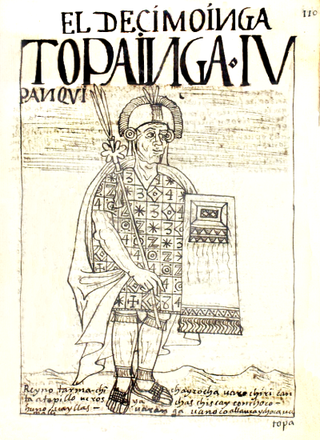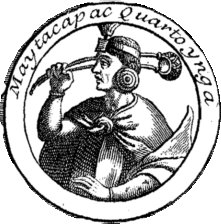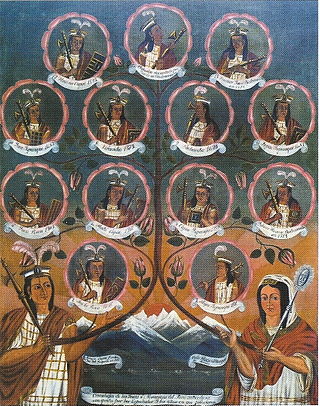
The Inca Empire, officially known as the Realm of the Four Parts, was the largest empire in pre-Columbian America. The administrative, political, and military center of the empire was in the city of Cusco. The Inca civilization rose from the Peruvian highlands sometime in the early 13th century. The Spanish began the conquest of the Inca Empire in 1532, and by 1572 the last Inca state was fully conquered.

Manco Cápac, also known as Manco Inca and Ayar Manco, was, according to some historians, the first governor and founder of the Inca civilization in Cusco, possibly in the early 13th century. He is also a main figure of Inca mythology, being the protagonist of the two best known legends about the origin of the Inca, both of them connecting him to the foundation of Cusco. His main wife was his older sister, Mama Uqllu, also the mother of his son and successor Sinchi Ruq'a. Even though his figure is mentioned in several chronicles, his actual existence remains uncertain.

In Inca mythology, Mama Ocllo, or more precisely Mama Uqllu, was deified as a mother and fertility goddess. In one legend she was a daughter of Inti and Mama Killa, and in another the daughter of Viracocha (Wiraqucha) and Mama Qucha. In all of them she was the older sister and wife of Manco Cápac, whom she established the city of Cusco with. In some variations, she also had a son with him, Sinchi Roca, though all Incan rulers after Manco Cápac were believed to be their descendants.

Pachacuti Inca Yupanqui, also called Pachacútec, was the ninth Sapa Inca of the Chiefdom of Cusco, which he transformed into the Inca Empire. Most archaeologists now believe that the famous Inca site of Machu Picchu was built as an estate for Pachacuti.

Atahualpa, also Atawallpa or Ataw Wallpa (Quechua), was the last effective Inca emperor, reigning from April 1532 until his capture and execution in July of the following year, as part of the Spanish conquest of the Inca Empire.

Huayna Capac was the third Sapa Inca of Tawantinsuyu, the Inca Empire. He was the son of and successor to Túpac Inca Yupanqui., the sixth Sapa Inca of the Hanan dynasty, and eleventh of the Inca civilization. He was born in Tumipampa and tutored to become Sapa Inca from a young age.

Manqu Inka Yupanki (Quechua) was the founder and monarch of the independent Neo-Inca State in Vilcabamba, although he was originally a puppet Inca Emperor installed by the Spaniards. He was also known as "Manco II" and "Manco Cápac II". He was one of the sons of Huayna Capac and a younger brother of Huascar.

Topa Inca Yupanqui or Túpac Inca Yupanqui, also Topa Inga Yupangui, erroneously translated as "noble Inca accountant" was the tenth Sapa Inca (1471–93) of the Inca Empire, fifth of the Hanan dynasty. His father was Pachacuti, and his son was Huayna Capac. Topa Inca belonged to the Qhapaq Panaca. His quya was his older sister, Mama Ocllo.

The Sapa Inca was the monarch of the Inca Empire, as well as ruler of the earlier Kingdom of Cuzco and the later Neo-Inca State. While the origins of the position are mythical and originate from the legendary foundation of the city of Cuzco, it seems to have come into being historically around 1100 AD. Although the Inca believed the sapa Inca to be the son of Inti and often referred to him as Inti churi "solar son" or Intip churin "son of the Sun", the position eventually became hereditary, with son succeeding father. The principal wife of the Inca was known as the coya or quya. The Sapa Inca was at the top of the social hierarchy, and played a dominant role in the political and spiritual realm.

Lluq'i Yupanki was the third Sapa Inca of the Kingdom of Cuzco and a member of the Hurin dynasty.

Mayta Qhapaq was the fourth Sapa Inca of the Kingdom of Cuzco and a member of the Hurin dynasty.

Inca Ruq'a was the sixth Sapa Inca of the Kingdom of Cusco and the first of the Hanan ("upper") Qusqu dynasty. His wife was Mama Michay, and his son was Yawar Waqaq.

Wiraqucha or Viracocha was the eighth Sapa Inka of the Kingdom of Cuzco and the third of the Hanan dynasty.

The Incas were most notable for establishing the Inca Empire which was centered in modern-day South America in Peru and Chile. It was about 4,000 kilometres (2,500 mi) from the northern to southern tip. The Inca Empire lasted from 1438 to 1533. It was the largest Empire in America throughout the Pre-Columbian era. The Inca state was known as the Kingdom of Cuzco before 1438. Over the course of the Inca Empire, the Inca used conquest and peaceful assimilation to incorporate the territory of modern-day Peru, followed by a large portion of western South America, into their empire, centered on the Andean mountain range. However, shortly after the Inca Civil War, the last Sapa Inca (emperor) of the Inca Empire was captured and killed on the orders of the conquistador Francisco Pizarro, marking the beginning of Spanish rule. The remnants of the empire retreated to the remote jungles of Vilcabamba and established the small Neo-Inca State, which was conquered by the Spanish in 1572.

Coricancha, Curicancha, Koricancha, Qoricancha or Qorikancha was the most important temple in the Inca Empire, and was described by early Spanish colonialists. It is located in Cusco, Peru, which was the capital of the empire.

The Comentarios Reales de los Incas is a book written by Inca Garcilaso de la Vega, the first published mestizo writer of colonial Andean South America. The Comentarios Reales de los Incas is considered by most to be the unquestioned masterpiece of Inca Garcilaso de la Vega, born of the first generation after the Spanish conquest.

The Kingdom of Cusco, also called the Cusco confederation, was a small kingdom based in the Andean city of Cusco that began as a small city-state founded by the Incas around the start of 13th century. In time, through warfare or peaceful assimilation, it began to grow into the Inca Empire (1438–1533).
Antonio Sinchi Roca Inka, was a Quechua painter from Peru and part of the Cuzco School.
Capac Yupanqui, was the brother of the Inca emperor Pachacuti and an Inca general.
Manco Sapaca was a man from the royal family of the Incas, the son of Sinchi Roca and the eldest brother of Mama Cawa, Mama Cuca and Lloque Yupanqui.

















